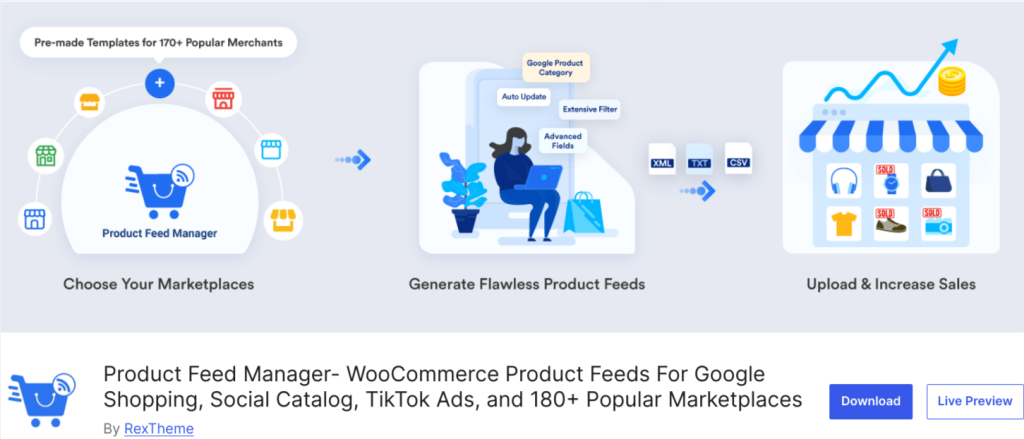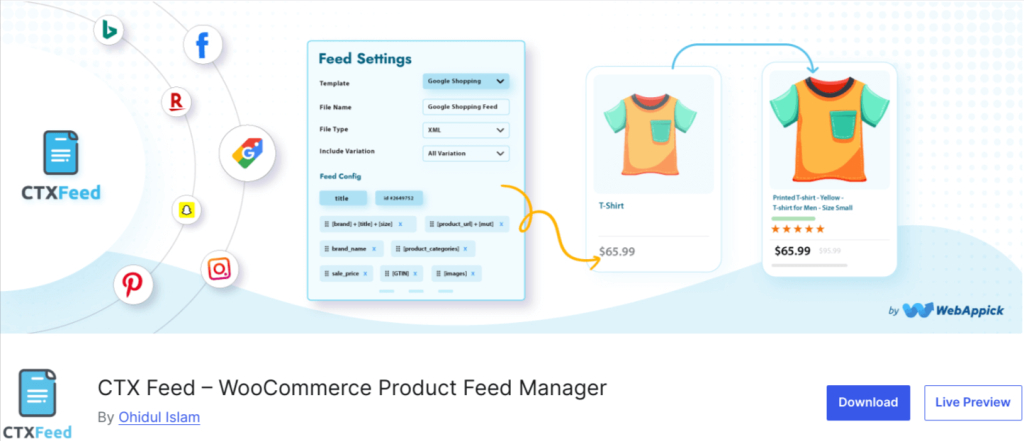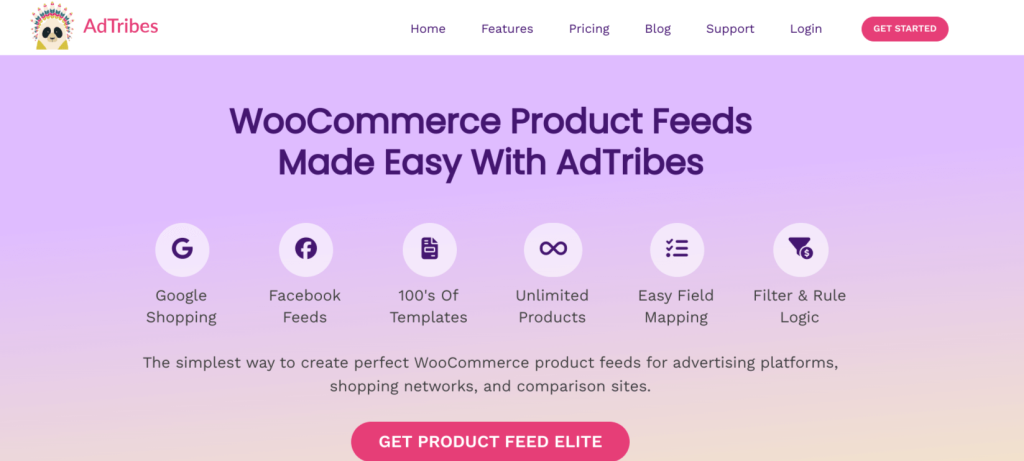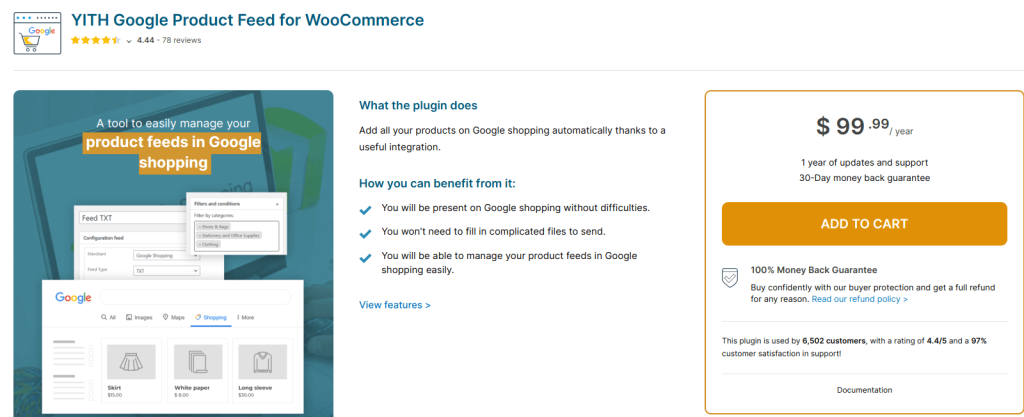WooCommerce product feeds serve as the critical bridge between your online store and the vast network of marketing platforms, shopping channels, and marketplaces.
According to recent eCommerce statistics, merchants who list their products on multiple channels see an average revenue increase of 38% compared to single-channel sellers.
This significant raise in performance underscores why getting the hang of product feed management is crucial for WooCommerce store owners.
As we navigate through this blog, you’ll learn:
- What is a WooCommerce product feed?
- 4 types of product feeds in WooCommerce
- Popular platforms requiring product feeds
- Creating WooCommerce product feeds in 2 methods
- Essential product feed attributes
- How to optimize your WooCommerce product feeds?
- Common product feed challenges and solutions
- Best WooCommerce product feed plugins
- Free vs. premium solutions
- Installation and setup process
What is a WooCommerce Product Feed?
A WooCommerce product feed is a file containing all your product information in a structured format that can be read by external platforms like Google Shopping, Facebook Marketplace, Amazon, and comparison shopping engines.
Also, it is a digital catalog that communicates critical product details – names, descriptions, prices, images, and availability to various marketing and sales channels.
Product feeds serve as the foundation for:
- Expanding visibility across major shopping platforms
- Synchronizing product information across channels
- Automating inventory and price updates
- Improving product discoverability in search engines
- Enabling dynamic remarketing campaigns
4 Types of Product Feeds in WooCommerce
When working with WooCommerce product feeds, you’ll encounter several format options, each with specific advantages for different platforms. Understanding these formats is essential for successful multi-channel selling.
CSV Product Feeds
The CSV (comma-separated values) format is the most common type of WooCommerce product feed. Also, its popularity stems from its simplicity and universal compatibility.
Advantages of CSV product feeds:
- Easy to create and modify using spreadsheet applications
- Supported by virtually all shopping platforms
- Lightweight files that process quickly
- Simple to troubleshoot and edit manually
However, CSV feeds have limitations when dealing with complex product structures or when character encoding becomes an issue.
XML Product Feeds
XML (eXtensible Markup Language) feeds offer more flexibility and structural capabilities than CSV formats, making them ideal for complex product catalogs.
Benefits of XML product feeds:
- Better handling of hierarchical data structures
- Support for special characters and formatting
- More detailed product attribute mapping
- Better error handling and validation
Google Merchant Center frequently recommends XML feeds for WooCommerce stores with complex product variations or extensive attribute sets.
JSON Product Feeds
JSON (JavaScript Object Notation) feeds are becoming increasingly popular, especially for modern API integrations and real-time data exchanges.
Advantages of JSON product feeds:
- Lightweight and faster processing
- Native integration with JavaScript applications
- Simpler syntax than XML
- Better support for nested product attributes
JSON feeds are particularly valuable when integrating with progressive web applications or headless commerce systems.
API-Based Product Feeds
Direct API connections represent the most advanced approach to product feed management, enabling real-time data synchronization.
Benefits of API-based feeds:
- Real-time inventory and price updates
- No need for scheduled feed uploads
- Lower risk of data inconsistencies
- Direct integration between systems
While more technically complex to implement, API-based WooCommerce product feeds offer the highest level of accuracy and automation for serious merchants.
Moreover, the choice between these formats often depends on the specific requirements of your target platforms and your technical capabilities. Many WooCommerce store owners utilize multiple feed formats simultaneously to optimize for different channels.
Popular Platforms Requiring WooCommerce Product Feeds
Each platform has unique requirements and specifications that affect how your products appear and perform. Some of the popular platforms requiring product feeds in WooCommerce are:
1. Google Shopping and Google Merchant Center
Google Shopping remains one of the most important channels for eCommerce visibility, with product listing ads generating up to 30% higher conversion rates than text ads.
Key requirements for Google Shopping feed WooCommerce integration:
- Unique product identifiers (GTIN, MPN, or Brand + MPN)
- Accurate product categorization using Google’s taxonomy
- High-quality images that meet dimensional requirements
- Precise pricing information, including tax and shipping
- Product availability status
Google Merchant Center serves as the hub for your product data, validating your WooCommerce product feed before making items eligible to appear in Google Shopping results.
2. Facebook Catalog and Instagram Shopping
Social commerce continues to grow rapidly, with Facebook and Instagram offering powerful selling capabilities through their integrated shopping features.
Facebook product catalog WooCommerce requirements:
- Consistent product identifiers
- At least one high-resolution product image
- Detailed product descriptions
- Accurate pricing and availability information
- URL links to product pages
Once your Facebook catalog is established, you can enable Instagram Shopping and create shoppable posts and stories, significantly expanding your social commerce potential.
3. Amazon, eBay, and Other Marketplaces
Major marketplaces like Amazon and eBay attract billions of visitors monthly, offering tremendous exposure potential for your WooCommerce products.
Marketplace feed requirements typically include:
- Category-specific attributes and classifications
- Marketplace-specific product identifiers
- Competitive pricing information
- Detailed shipping and handling policies
- Inventory threshold settings
But, each marketplace has unique specifications. Making a flexible WooCommerce product feed manager is essential for success across multiple platforms.
4. Comparison Shopping Engines
Comparison shopping engines (CSEs) like PriceGrabber, Shopzilla, and Shopping.com help price-conscious consumers find the best deals.
CSE feed requirements often include:
- Competitive pricing information
- Shipping costs and policies
- Product condition details
- Stock availability
- Detailed product attributes for filtering
CSEs can drive highly qualified traffic to your store, as visitors are typically in the final stages of the purchasing journey and comparing options.
These platform-specific requirements are crucial when configuring your WooCommerce product feed setup.
How to Create WooCommerce Product Feeds: 2 Methods
Setting up effective product feeds for your WooCommerce store can be approached in several ways, from manual creation to using specialized product feed plugins for WooCommerce.
Now, let’s explore the two methods to help you determine the best approach for your business.
Method 1: Manual Methods for Creating Product Feeds
For store owners with technical expertise or smaller product catalogs, manually creating WooCommerce product feeds is a viable option.
Here are the steps for manual product feed creation:
- Firstly, export your WooCommerce products using the built-in CSV export tool
- Open the exported file in a spreadsheet application like Excel or Google Sheets
- Next, modify the data structure to match your target platform’s requirements
- Add missing required attributes and optimize existing content
- Save the file in the appropriate format (CSV, XML, etc.)
- Finally, upload the feed to your target platform and set a refresh schedule
This approach offers complete control but becomes time-consuming as your catalog grows or when managing multiple platforms.
Method 2: Using WooCommerce Product Feed Plugins
For most store owners, WooCommerce product feed plugins provide the ideal balance of control and automation.
Benefits of using product feed plugins:
- Automated feed generation and updates
- Pre-configured templates for major platforms
- Attribute mapping interfaces for customization
- Scheduled feed refreshes
- Error reporting and troubleshooting tools
- Filter options to include/exclude specific products
And, popular plugins like Product Feed PRO, WooCommerce Google Product Feed, and YITH WooCommerce Catalog Mode offer varying features to match different needs and budgets.
How to Choose the Right Product Feed Solution
Selecting the optimal approach for WooCommerce product feed generation depends on several factors:
Consider these criteria when choosing your solution:
- Catalog size and complexity – Larger catalogs with many variations typically benefit from specialized plugins
- Technical resources – Manual approaches require more technical knowledge
- Number of target platforms – Multi-channel selling virtually necessitates automation
- Update frequency – Rapidly changing inventory or multiple pricing requires automated solutions
- Budget considerations – Balance the cost of plugins against time savings and revenue potential.
In conclusion, for most growing WooCommerce stores, investing in a quality product feed plugin delivers the best ROI through time savings and improved feed quality, which directly impacts channel performance.
When implementing your chosen solution, start with one platform and perfect your feed before expanding to additional channels. This methodical approach helps identify and resolve common issues before they affect your broader distribution strategy.
Essential Product Feed Attributes in WooCommerce
Creating high-performing WooCommerce product feeds requires understanding which attributes are mandatory, which are recommended, and how to optimize them for different platforms.
Now, let’s explore the essential elements that make up effective product feeds.
Required WooCommerce Product Attributes for Different Platforms
While requirements vary by platform, certain core attributes are universally important in WooCommerce product feeds:
Universal required attributes:
- Product ID – A unique identifier for each product
- Title – The product name as it will appear on the platform
- Description – Detailed product information
- Link – URL pointing to the product page
- Image link – URL of the main product image
- Price – Current selling price
- Availability – In stock, out of stock, or preorder status
Google Shopping additional requirements:
- GTIN – Global Trade Item Number (when available)
- MPN – Manufacturer Part Number (if no GTIN exists)
- Brand – Product’s brand name
- Google Product Category – Classification using Google’s taxonomy
Facebook Catalog specifics:
- Facebook Product Category – Classification using Facebook’s taxonomy
- Condition – New, used, or refurbished status
- Age Group – Target demographic (for apparel)
- Gender – Target demographic (for applicable products)
Ensuring these required attributes are accurately mapped in your WooCommerce product feed setup will prevent feed rejections and listing disapprovals.
Optional Attributes That Improve Performance
Beyond the mandatory fields, certain optional attributes can significantly enhance your product feed effectiveness:
Performance-boosting optional attributes:
- Sale price – Promotional pricing with start/end dates
- Additional images – Secondary product views
- Color – Product color variations
- Size – Size variations for applicable products
- Material – Product composition information
- Pattern – Design pattern information
- Custom labels – For campaign segmentation
- Shipping information – Detailed shipping costs and methods
- Tax information – Applicable tax rates and rules
These additional attributes, improve product discoverability through filtering, enhance the shopping experience, and provide more targeting options for advertising campaigns.
Mapping WooCommerce Data to Feed Attributes
Effective attribute mapping ensures your WooCommerce product data translates properly to external platform requirements:
Best practices for WooCommerce feed attributes mapping:
- Create a mapping strategy – Document how each WooCommerce field corresponds to feed attributes
- Utilize custom fields – Leverage WooCommerce custom fields for platform-specific attributes
- Implement attribute hierarchies – Determine fallback values when primary attributes are missing
- Standardize formats – Ensure consistent formatting for prices, dates, and measurements
- Implement transformations – Convert units or formats as needed for different platforms
Most WooCommerce product feed plugins offer visual mapping interfaces that simplify this process, but understanding the underlying principles ensures you can troubleshoot issues and optimize performance.
Proper attribute management directly impacts your products’ visibility and conversion potential across all sales channels, making it one of the most critical aspects of feed management.
How to Optimize Your WooCommerce Product Feeds?
Creating a functional WooCommerce product feed is just the beginning. To take it further, you need to optimize each component of your feed to increase performance across shopping channels.
Let’s explore strategies to enhance your product data for better visibility and conversion.
Product Title Optimization
The product title is often the most influential element for search visibility and click-through rates in shopping feeds.
Title optimization techniques:
- Front-load important keywords – Place the most relevant terms at the beginning
- Include key product attributes – Brand, model, size, color, material
- Next, maintain ideal length – 70-150 characters depending on the platform
- Use consistent formatting – Create a repeatable pattern across products
- Avoid keyword stuffing – Titles should read naturally while being informative
Example of an optimized title: ❌ “Blue T-Shirt” ✅ “Nike Dri-FIT Men’s Running T-Shirt – Moisture-Wicking Blue Athletic Top (Medium)”
Research shows that, properly optimized titles can improve CTR by up to 30% in Google Shopping product feeds. Therefore, investing time in title optimization can significantly boost your feed performance.
Description Optimization Techniques
While titles capture attention, descriptions convert browsers to buyers by addressing potential questions and highlighting benefits.
Description optimization best practices:
- Highlight unique selling points – What distinguishes this product?
- Include secondary keywords – Terms not in the title but relevant to searches
- Address common questions – Preemptively answer buyer concerns
- Use bulleted formats (when supported) – Improve scanability
- Include dimensions and specifications – Provide precise details
- Maintain appropriate length – Comprehensive without overwhelming
Well-crafted descriptions reduce return rates by setting accurate expectations while improving keyword relevance for WooCommerce product feed optimization.
Image Optimization for Product Feeds
Images dramatically impact shopping feed performance, with high-quality visuals increasing conversion rates by up to 40%.
Image optimization guidelines:
- Follow platform-specific requirements – Adhere to size, format, and background guidelines
- Use high-resolution images – Minimum 800×800 pixels for most platforms
- Maintain consistent aspect ratios – Typically square (1:1) works best
- Show the product clearly – Main image should clearly display the item
- Use white backgrounds – Especially for Google Shopping and Amazon
- Optimize file sizes – Balance quality with load speed
- Include multiple angles – Provide additional image links when possible
Remember that different platforms may have distinct image requirements, so customize your WooCommerce product feed for each destination.
Price and Availability Optimization
Accurate and strategic price and availability information prevents disapprovals while maximizing competitiveness.
Price and availability best practices:
- Ensure real-time accuracy – Outdated pricing leads to customer frustration
- Include sale prices with dates – Highlight limited-time offers
- Add tax and shipping information – Provide total cost transparency
- Set inventory thresholds – Prevent overselling by updating availability status
- Use price competitiveness tools – Adjust pricing based on market analysis
- Implement microdata – Add structured data on your site to reinforce feed information
Also, products with consistently accurate pricing and availability information receive preferential treatment in many shopping platforms’ algorithms.
By systematically optimizing each element of your WooCommerce product feed, you create a powerful distribution channel that drives qualified traffic and converts browsers into buyers across multiple platforms.
Common Product Feed Challenges and Solutions
Even well-planned WooCommerce product feeds can encounter obstacles. Understanding common challenges and their solutions helps you maintain high-quality feeds and avoid potential pitfalls.
Handling Product Variations
Product variations like size, color, or material often create complications in feed management.
Challenges with variations:
- Platforms have different requirements for variation handling
- Maintaining unique identifiers for each variant
- Ensuring consistent attribute mapping across variations
- Managing variation-specific images
Solutions:
- Use parent-child relationships – When supported by the platform
- Create individual listings – For platforms requiring separate entries
- Implement variation-specific attributes – Map color, size, etc., correctly
- Utilize variation-specific images – Show the exact product configuration
- Maintain consistent naming conventions – Connect variations through standardized titles
Proper variation handling in your WooCommerce product feed setup improves user experience and prevents listing errors.
Managing Out-of-Stock Products
Inventory management directly impacts feed performance and customer satisfaction.
Common inventory challenges:
- Determining whether to include out-of-stock items
- Handling backordered products
- Managing pre-order items
- Updating availability status efficiently
Solutions:
- Set platform-specific rules – Some platforms benefit from keeping out-of-stock items, others don’t
- Implement availability thresholds – Update status before completely running out
- Use clear availability labels – “In stock,” “Out of stock,” “Available for pre-order,” etc.
- Configure restock notifications – Alert customers when products return to inventory
- Schedule frequent feed updates – Keep availability information current
Research shows that accurate inventory management reduces cart abandonment by up to 25%.
Updating Product Information Automatically
Keeping product information current across multiple channels presents significant challenges.
Information synchronization issues:
- Manual updates are becoming unmanageable as the catalog grows
- Inconsistent information across platforms
- Time delays in updates appearing across channels
Solutions:
- Implement automated synchronization – Use plugins that support real-time or scheduled updates
- Establish update hierarchies – Determine which attributes require immediate updates vs. batch processing
- Configure update triggers – Set specific events that initiate feed refreshes
- Leverage incremental updates – Update only changed products when possible
- Monitor update logs – Track successful and failed updates
Automation is essential for maintaining dynamic WooCommerce product feeds across multiple platforms without errors.
Troubleshooting Feed Errors
Feed rejections and errors can significantly impact your multi-channel selling success.
Common feed error causes:
- Missing required attributes
- Incorrect data formats
- Policy violations in content
- Image issues
- Pricing inconsistencies
Troubleshooting approach:
- Review error reports – Understand specific issues from platform diagnostics
- Implement systematic fixes – Address problems by category rather than individually
- Create validation rules – Prevent errors before feed submission
- Test with smaller feeds – Validate fixes with sample data before full submission
- Document common issues – Create an internal knowledge base of resolved problems
When troubleshooting common WooCommerce product feed errors, focus on systematic solutions rather than one-off fixes to prevent recurring problems.
By addressing these common challenges proactively, you can maintain high-quality product feeds that perform consistently across all your sales channels.
Advanced Product Feed Strategies
Once you’ve mastered the fundamentals of WooCommerce product feeds, implementing advanced strategies can significantly enhance your multi-channel performance. These tactics help you move beyond basic compliance to create truly optimized feeds for each destination.
Feed Segmentation for Different Channels
Different platforms attract different customer segments with varying purchase behaviors and preferences.
Benefits of channel-specific segmentation:
- Tailored content for platform-specific audiences
- Optimized product selection by channel
- Platform-appropriate pricing strategies
- Channel-specific promotional strategies
Implementation strategies:
- Create platform-specific feeds – Customize content for each destination
- Use custom labels – Categorize products for specific channels or campaigns
- Implement channel exclusions – Remove underperforming products from certain platforms
- Adjust inventory allocation – Control availability across channels
- Set channel priorities – Determine which channels get preference during stock limitations
WooCommerce multi-channel feeds perform best when tailored to each platform’s unique audience and requirements.
Dynamic Pricing in Product Feeds
Price is often the decisive factor in purchase decisions, making dynamic pricing a powerful competitive tool.
Dynamic pricing capabilities:
- Competitive repricing based on market analysis
- Time-limited promotional pricing
- Bundle and quantity-based discounts.
- Customer segment-specific pricing
- Margin protection rules
Implementation approaches:
- Use specialized dynamic pricing plugins – Tools that adjust prices based on rules
- Implement feed-specific price formulas – Calculate prices for each channel
- Schedule promotional periods – Set beginning and end dates for sales
- Create minimum advertised price rules – Protect brand value while remaining competitive
- Configure competitor-based repricing – Adjust based on market position
Dynamic product feeds in WooCommerce enable sophisticated pricing strategies that maximize both sales volume and profitability.
Promotional Feeds for Special Events
Limited-time events and seasonal promotions often deserve specialized feed strategies.
Event-based feed optimization:
- Holiday shopping campaigns
- Flash sales and limited-time offers
- Seasonal product highlighting
- New collection launches
- Clearance and inventory reduction events
Implementation tactics:
- Create event-specific feeds – Dedicated feeds for major promotional periods
- Use promotional_id attributes – Connect products to specific campaigns
- Implement sale price start/end dates – Automate promotional pricing
- Develop seasonal title enhancements – Add event-relevant keywords during peak seasons
- Prioritize promotional inventory – Ensure featured products remain in stock
Promotional feed strategies enable you to capitalize on high-traffic shopping periods while maintaining your standard product distribution.
A/B Testing Product Feed Content
Systematic testing of feed elements helps identify the most effective approaches for each platform.
Elements suitable for A/B testing:
- Product titles (format, length, keyword positioning)
- Image styles and backgrounds
- Description formats and emphasis
- Pricing presentation (with/without strike-through pricing)
- Product categorization approaches
Testing methodology:
- Isolate variables – Test one element at a time
- Use statistically significant samples – Test enough products to validate results
- Set clear success metrics – Determine KPIs before testing
- Implement tracking mechanisms – Monitor performance differences
- Document and apply findings – Systematically implement successful approaches
Continuous testing and optimization of your WooCommerce product feed content can lead to significant performance improvements over time.
Advanced feed strategies require more sophisticated tools and approaches, but the increased complexity pays dividends through improved visibility, click-through rates, and conversion rates across all your sales channels.
Best WooCommerce Product Feed Plugins
Here are the best WooCommerce product feed plugins to help you make an informed decision.
Each plugin offers distinct features, pricing models, and specializations that aligns better with certain business types.
1. Product Feed Manager by RexTheme – Free + Premium

Simplifies the creation of product feeds for over 180 marketplaces, including Google Shopping, Facebook, and TikTok.
- Key strengths: Extensive marketplace support, pre-defined merchant templates
- Best for: Store owners targeting multiple global platforms
- Unique features: Advanced category mapping, automated feed updates, batch processing for large product catalogs
- Limitations: The free version supports up to 200 products; upgrading to the Pro version is necessary for unlimited product feeds.
- Pricing: Free version available | Premium version starts at 67.99 / year.
2. CTX Feed by WebAppick – Free + Premium

Offers optimized, error-free product feeds for over 100 channels, including Google Shopping and Facebook.
- Key strengths: Wide channel compatibility, dynamic attribute support
- Best for: Stores seeking automated, multi-channel feed management
- Unique features: Smart and advanced filtering, auto-updates, multilingual and multi-currency support, unlimited products and feeds
- Limitations: Advanced features can present a learning curve for new users.
- Pricing: Free version available | Premium version starts at $119 per year for a single site license.
3. Product Feed for WooCommerce by WebToffee – Free + Premium

Enables the creation of feeds for platforms such as Google Shopping, Pinterest, and TikTok. It will help you generate optimized WooCommerce product feeds in XML, CSV, XLSX, TXT formats.
- Key strengths: Supports multiple major sales channels, seamless integration
- Best for: Businesses aiming to expand product reach across various platforms
- Unique features: Pre-defined templates, automated feed updates, support for custom fields and taxonomies
- Limitations: Lacks some advanced customization options found in other plugins.
- Pricing: Free version available | Premium version starts at $89.00 /year.
4. WooCommerce Product Feeds by AdTribes – Premium

Facilitates management of product feeds across multiple platforms with advanced features. It support hundreds of marketing channels, from big advertising networks like Google, Meta/Facebook, and Bing through to lesser known shopping comparison engines, marketplaces, and more.
- Key strengths: Unlimited products and feeds, advanced filtering
- Best for: Stores requiring precise control over product data
- Unique features: Category mapping, rule-based filtering, support for custom fields
- Limitations: The interface may be less intuitive for beginners.
- Pricing: Free version not available | Pricing starts at 99.50 / year
5. YITH Google Product Feed for WooCommerce – Premium

YITH’s product feed plugin for WooCommerce easily manage your product feeds in Google shopping.
- Key strengths: Seamless integration with Google Merchant Center, customizable feed templates
- Best for: Store owners aiming to enhance product visibility on Google Shopping.
- Unique features: Unlimited feed creation, advanced filtering by category or tag, custom field with Google attributes.
- Limitations: Lacks support for platforms beyond Google Shopping, limited advanced customization options.
- Pricing: Free version not available | Pricing starts at $ 99.99/ year.
Considerations While Choosing Between Free vs. Premium Solutions
Understanding the trade-offs between free and paid WooCommerce product feed plugins helps you make appropriate investments.
Free plugin considerations:
- Usually limited to one or few platforms
- Basic mapping and customization capabilities
- Limited or community-based support
- Fewer automated optimization features
- Often adequate for small stores with simple products
Premium plugin advantages:
- Multi-platform support with specialized templates
- Advanced attribute mapping and transformation tools
- Priority technical support
- Automated optimization features
- Regular updates for platform requirement changes
- Time savings through automation and error prevention
Most growing businesses find that premium solutions deliver strong ROI through increased channel performance and time savings, especially when managing feeds for multiple platforms.
Installation and Setup Guide
Proper implementation of your chosen WooCommerce product feed plugin ensures optimal performance.
General setup process:
- Research and select – Choose the plugin that best matches your needs
- Installation – Upload and activate through WordPress admin
- Configuration – Set global settings and defaults
- Feed creation – Set up individual feeds for each target platform
- Attribute mapping – Connect WooCommerce data to feed requirements
- Filter configuration – Determine which products to include/exclude
- Validation – Test feed output against platform requirements
- Scheduling – Set up automatic refresh intervals
- Integration – Connect feed URLs to destination platforms
- Monitoring – Implement regular feed health checks
When configuring your WooCommerce product feed plugin, prioritize accuracy over speed.
This is because a properly implemented feed provides long-term benefits through higher approval rates and better channel performance.
Furthermore, the best plugin for your store depends on your specific requirements, technical capabilities, and business goals. Therefore, evaluate options based on the channels you prioritize, your catalog complexity, and your team’s technical expertise.
Conclusion
Throughout this comprehensive guide, we’ve explored the critical aspects of creating, optimizing, and managing WooCommerce product feeds for multi-channel selling success. Let’s now summarize the key takeaways and provide actionable next steps for implementation.
Key Takeaways
- WooCommerce product feeds serve as the foundation for multi-channel eCommerce success, enabling product visibility across numerous shopping platforms
- Different feed formats (CSV, XML, JSON, API) offer varying advantages for different platforms and use cases
- Each shopping platform has unique product feed requirements that must be met for optimal performance
- Feed creation can be handled manually or through specialized plugins, with automation becoming increasingly important as your catalog grows
- Essential product attributes must be properly mapped and optimized for each destination platform
- Content optimization strategies for titles, descriptions, images, and pricing significantly impact feed performance
- Common challenges like variation handling, inventory management, and error troubleshooting require systematic approaches
- Advanced strategies including feed segmentation, dynamic pricing, and A/B testing can dramatically improve multi-channel results
- Finally, the right WooCommerce product feed plugin selection depends on your specific business needs, technical capabilities, and growth aspirations
Other helpful resources:
- How to Sell WooCommerce Digital Download Products?
- How to Set Up WooCommerce Shipping Options
- How to Set Up WooCommerce Dynamic Pricing and Discounts?
- 5 Best WooCommerce Product filter plugins (Free + Paid)
- 5 Best WooCommerce Subscription Plugins in 2025
- 5 Best WooCommerce Discount Plugins (Free & Paid)
- 7 Best Bulk Discount Plugins For WooCommerce Stores
- 5 Best WooCommerce Coupon Code Generator
Frequently Asked Questions
Product feeds are used to distribute product information across multiple online sales channels, marketing platforms, comparison shopping engines, and advertising networks efficiently.
Create a product feed by extracting product data from your e-commerce platform, formatting it in XML or CSV, and including essential details like price, description, and images.
WooCommerce can technically handle 100,000 products, but performance may suffer. Optimize with caching, efficient hosting, and potentially use additional plugins for large catalogs.
Bulk import WooCommerce products using built-in CSV importer, third-party plugins like “Product CSV Import Export”, or advanced solutions like WP All Import for seamless integration.





